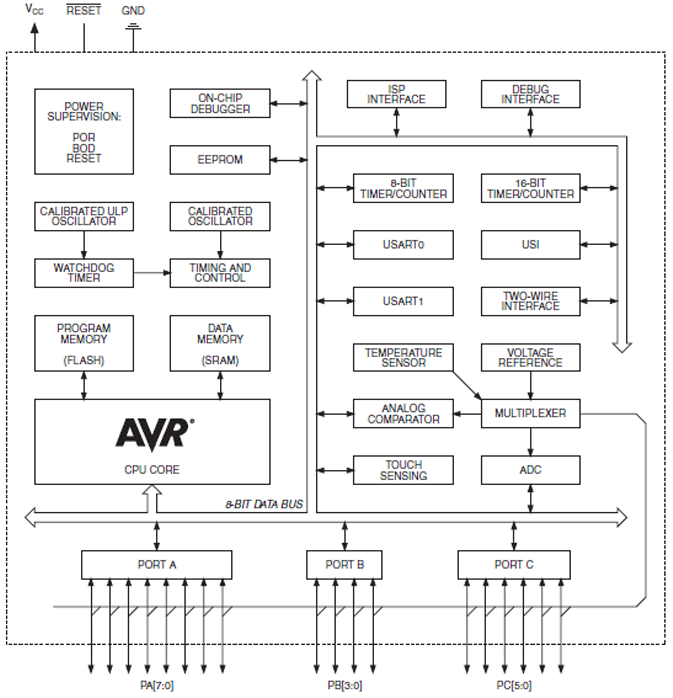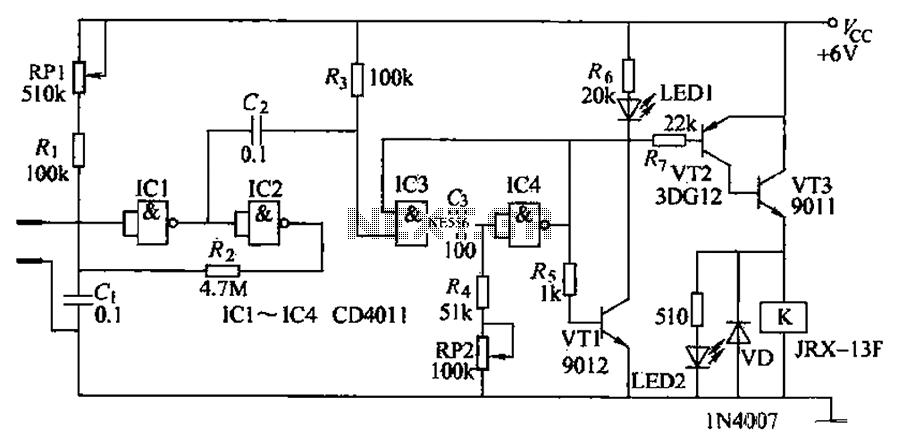
atmelATtiny1634 circuit

The ATtiny1634 8-Bit AVR Microcontroller from Atmel is based on the enhanced RISC architecture of AVR. It can execute powerful instructions in a single clock cycle, achieving throughputs close to 1 MIPS per MHz. This allows system designers to balance power consumption with processing speed. The AVR core features a comprehensive instruction set and includes 32 general-purpose working registers. These registers are directly connected to the Arithmetic Logic Unit (ALU), enabling access to two independent registers in a single instruction executed within one clock cycle. This architecture is compact and efficient, delivering throughputs up to ten times faster than traditional CISC microcontrollers.
The ATtiny1634 microcontroller is designed for applications requiring high performance and low power consumption. Its RISC architecture is characterized by a reduced set of instructions that can be executed in a single cycle, which significantly enhances processing speed. The ability to achieve nearly 1 MIPS per MHz allows for efficient operation in battery-powered devices or applications where energy efficiency is critical.
The microcontroller features a total of 32 general-purpose working registers, which are essential for performing arithmetic and logic operations. The direct connection of these registers to the ALU facilitates rapid data access and manipulation, allowing for two registers to be processed simultaneously. This dual-access capability is a distinctive advantage of the ATtiny1634, enabling more complex operations to be performed in minimal time, thus improving overall system performance.
Additionally, the compact architecture of the ATtiny1634 contributes to its efficiency, as it requires less memory space for instruction storage compared to CISC microcontrollers. This compactness is beneficial in applications where space is limited, such as in embedded systems or portable devices. The efficient instruction set also leads to reduced code size, which further conserves memory resources.
In summary, the ATtiny1634 microcontroller is a robust solution for developers seeking a high-performance, low-power microcontroller that excels in processing speed and efficiency. Its architecture is particularly suited for applications in consumer electronics, automation, and other fields where both processing power and energy efficiency are paramount.Atmel`s ATtiny1634 8-Bit AVR ® Microcontroller is based on the AVR ® enhanced RISC architecture. By executing powerful instructions in a single clock cycle, the ATtiny1634 achieves throughputs approaching 1 MIPS per MHz allowing the system designer to optimize power consumption versus processing speed. The AVR ® core combines a rich instruction se t with 32 general purpose working registers. All 32 registers are directly connected to the Arithmetic Logic Unit (ALU), allowing two independent registers to be accessed in a single instruction, executed in one clock cycle. The resulting architecture is compact and code efficient while achieving throughputs up to ten times faster than conventional CISC microcontrollers.
🔗 External reference
The ATtiny1634 microcontroller is designed for applications requiring high performance and low power consumption. Its RISC architecture is characterized by a reduced set of instructions that can be executed in a single cycle, which significantly enhances processing speed. The ability to achieve nearly 1 MIPS per MHz allows for efficient operation in battery-powered devices or applications where energy efficiency is critical.
The microcontroller features a total of 32 general-purpose working registers, which are essential for performing arithmetic and logic operations. The direct connection of these registers to the ALU facilitates rapid data access and manipulation, allowing for two registers to be processed simultaneously. This dual-access capability is a distinctive advantage of the ATtiny1634, enabling more complex operations to be performed in minimal time, thus improving overall system performance.
Additionally, the compact architecture of the ATtiny1634 contributes to its efficiency, as it requires less memory space for instruction storage compared to CISC microcontrollers. This compactness is beneficial in applications where space is limited, such as in embedded systems or portable devices. The efficient instruction set also leads to reduced code size, which further conserves memory resources.
In summary, the ATtiny1634 microcontroller is a robust solution for developers seeking a high-performance, low-power microcontroller that excels in processing speed and efficiency. Its architecture is particularly suited for applications in consumer electronics, automation, and other fields where both processing power and energy efficiency are paramount.Atmel`s ATtiny1634 8-Bit AVR ® Microcontroller is based on the AVR ® enhanced RISC architecture. By executing powerful instructions in a single clock cycle, the ATtiny1634 achieves throughputs approaching 1 MIPS per MHz allowing the system designer to optimize power consumption versus processing speed. The AVR ® core combines a rich instruction se t with 32 general purpose working registers. All 32 registers are directly connected to the Arithmetic Logic Unit (ALU), allowing two independent registers to be accessed in a single instruction, executed in one clock cycle. The resulting architecture is compact and code efficient while achieving throughputs up to ten times faster than conventional CISC microcontrollers.
🔗 External reference





